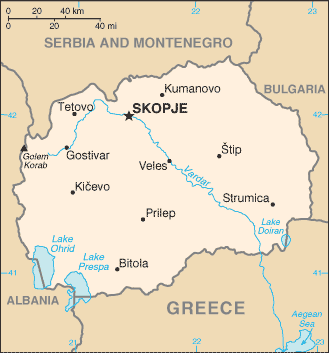Macedonia
Macedonia is a geographical and historical region of the Balkan peninsula in south-eastern Europe with an area of about 67,000 square kilometres and a population of 4,76 million. The territory corresponds to the basins of (from west to east) the Aliakmon, Vardar/Axios and Struma/Strymon rivers (of which the Axios/Vardar drains by far the largest area) and the plains around Thessaloniki and Serrai. The region is divided between Greece, with roughly half of the area and population, split between the three peripheries of Central Macedonia, West Macedonia, and East Macedonia and Thrace; the Former Yugoslav Republic of Macedonia¤, with around 40%; and Bulgaria, with less than a tenth, in Blagoevgrad Province. The Greek part is sometimes referred to (by non-Greeks mainly) as Greek Macedonia or "Aegean Macedonia", the Republic of Macedonia as "Vardarska Banovina" and the Bulgarian part as Bulgarian Macedonia or "Pirin Macedonia". The name of Macedonia has not been always used with regard to the region as defined above. In its beginnings, the ancient state of Macedon encompassed only a part of this region. Later, throughout the Middle Ages, the name was used to refer to southern Thrace and the Rhodopes, an area divided now between Bulgaria, Greece, and Turkey, whereas present-day Macedonia was called in a number of different ways by the Byzantine Empire and the Slavic kingdoms, which ruled over the region. After the revival of Greek, Serbian, and Bulgarian statehood in the 19th century, Macedonia became a focus of the national ambitions of all three governments, leading to the creation in the 1890s and 1900s of rival armed groups who divided their efforts between fighting the Turks and one another. The most important of these was the Bulgarian-sponsored Internal Macedonian Revolutionary Organization (VMRO), under Goce Delchev who in 1903 rebelled in the so-called Ilinden uprising, and the Greek efforts from 1904 till 1908 (Greek Struggle for Macedonia). Diplomatic intervention by the European powers led to plans for an autonomous Macedonia under Ottoman rule. During World War II the boundaries of the region shifted yet again. When the German forces occupied the area, most of Yugoslav Macedonia and part of Greek Macedonia were transferred for administration to Bulgaria.Western Greek Macedonia was occupied by Italy, with the western parts of Yugoslav Macedonia being annexed to Italian-occupied Albania. The remainder of Greek Macedonia (including all of the coast) was occupied by Nazi Germany. One of the worst episodes of the Holocaust happened here when 60,000 Jews from Thessaloniki were deported to extermination camps in occupied Poland. Only a few thousand survived. Macedonia was liberated in 1944, when the Red Army's advance in the Balkan Peninsula forced the German forces to retreat. The pre-war borders were restored under U.S. and British pressure because the Bulgarian government was insisting to keep its military units on Greek soil. The Yugoslav communist leader Josip Broz Tito separated Yugoslav Macedonia from Serbia after the war. It became a republic of the new federal Yugoslavia (as the Socialist Republic of Macedonia) in 1946, with its capital at Skopje. Across the border in Greece, Macedonian Slavs were seen as a potentially disloyal "fifth column" within the Greek state. The existence of a Slav minority was officially denied, with Macedonian Slavs referred to in official censuses as being merely "Slavophone" Greeks. Bulgaria initially accepted the existence of a distinctive Macedonian identity, but it was under Soviet and Yugoslav pressure. It had been agreed that Pirin Macedonia would join Yugoslavian Macedonia and for this reason the population was forced to declare itself "Macedonian" in the 1946 census. In 1991, Yugoslav Macedonia held a referendum on independence which produced an overwhelming majority in favour, although it was boycotted by the Macedonian Slav Albanians. The republic seceded peacefully from the Yugoslav federation, declaring its independence as the Republic of Macedonia. The move received, however, the support only of Bulgaria. The Bulgarians were hoping that the independence of the Republic of Macedonia would reduce Serbian influence in the country and would eventually lead to the "re-Bulgarisation" of its population. Bulgaria was consequently the first country to officially recognise Republic of Macedonia independence - as early as February 1992. However, the Bulgarians refused and have refused so far to recognise the existence of a separate Macedonian language and a separate Macedonian Slav nation. This article is licensed under the GNU Free Documentation License. It uses material from the Wikipedia article "Macedonia ". |
||||||||||

